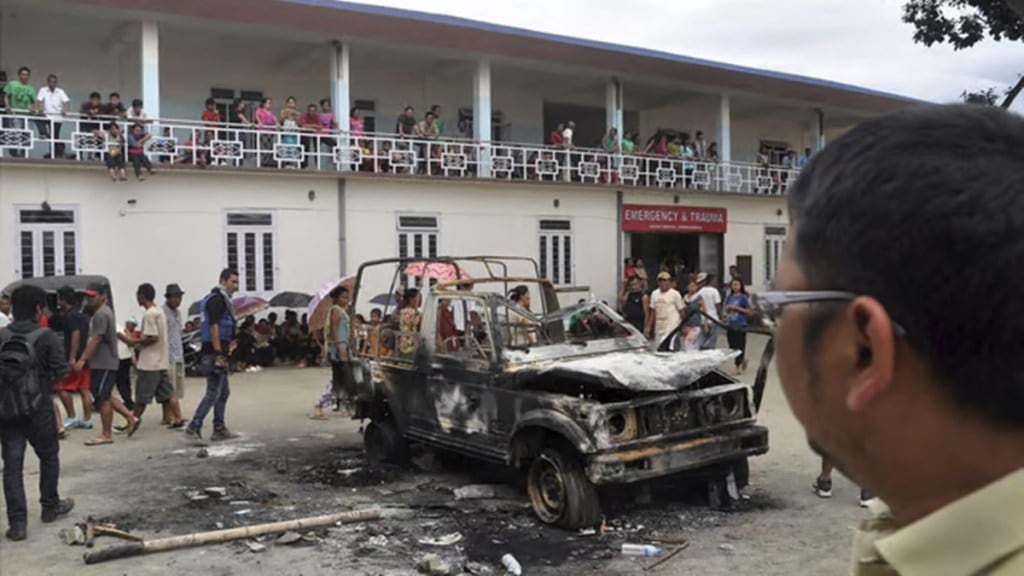A year has passed since the last time Manipur saw any resemblance of peace and harmony. The serene hill state located in India’s northeast has been caught up in a spiral of violence since May 3, 2023, with thousands displaced, hundreds killed and several missing till date. A year of violence in Manipur has made people lose their businesses, homes, properties, loved ones and has snatched from them a chance to return to normality.
As on record, more than 200 people have been killed and several hundred injured but reports from the ground indicate that the atrocities are more widespread than that. Behind the violence are claims and counter-claims over land and special benefits of two communities—Meiteis and Kuki-Zo tribes—in a state divided along religious and ethnic lines.
Also Read: Clash in Manipur: Meitei women vigilantes confront security forces, seize detainees
What has happened in a year?
The violence was triggered by a high court order in March last year that recommended the Meitei community, which constitutes 53 per cent of the population, to be included in the list of Scheduled Tribes (ST) in the state.
The protests grew louder and a day before Biren Singh’s visit to Churachandpur on April 27, a gym he was going to inaugurate was set on fire. Curfews and internet shutdowns followed. Tensions flared further after a Tribal Solidarity March organised by the All-Tribal Students Union of Manipur (ATSUM) in which about 60,000 people are said to have participated.
This gained national attention, becoming a battleground of competing narratives, further deepening the rift between the Meiteis and Kuki-Zo tribes. Violence shifted from Imphal and Churachandpur to peripheral areas of Imphal valley as well, with both sides resorting to intense gunfights and ambushes.
The Meiteis and the Kukis have been fighting for a year now, with both communities sharply divided on ethnic lines, and each not going to areas where the other is dominant. The central forces stand between them in what is now known as “sensitive zones”, mostly in the foothills.
Also Read: Manipur violence: Village volunteer killed, two injured in gunfight in Kangpokpi district
Both the Meitei and the Kuki communities in cities across the country including Delhi and Bengaluru have planned gatherings on Friday to observe a year of loss since the clashes began on May 3 last year.
Nearly 50,000 internally displaced people still living in relief camps, at least 13,247 structures have been gutted or destroyed and nearly 28 people missing or presumed kidnapped or murdered in these past 12 months. The clashes may have simmered down now but sporadic incidents have been occurring in different parts of the state almost daily.
The 12 months of violence has severely hit businesses, schools, colleges and other institutions, besides disrupting transportation and communication networks. It also affected the agrarian sector, considered the mainstay of Manipur’s economy.
In a year, hundreds of cases of crimes have come to the fore, with several of them still being investigated by the Central Bureau of Investigation (CBI) which took over 27 cases of violence in August last year that were earlier being probed by the state police.
Also Read: Lok Sabha polls: People displaced due to Manipur violence to cast votes in relief camps, says ECI
One of these include the grimmest incidents that brought women to the centrestage of Manipur violence. A video went viral last July of two Kuki women who were stripped and paraded naked purportedly by a Meitei mob in a paddy field. They were allegedly gang-raped subsequently. The incident is said to have happened on May 4 right after the ethnic clashes broke out.
What needs to be done?
From the perspective of law-and-order, one of the biggest challenge to bring about normalcy in the strife-torn state remains the prevalence of looted arms among civilians on both sides of the communal divide. A police officer estimated that while around 2,000 weapons seized from security establishments during the course of the conflict have been recovered, another 4,000 continue to be in the hands of civilians, Indian Express reported.
However, the officer emphasised that “security is just part of the solution”.
An Assam Rifles official also underlined the need for “a political solution” to the conflict, while also flagging “misinformation on social media stoking tensions” as an obstacle to law and order, IE reported.
Also Read: Manipur violence: Three mutilated bodies of village guards found in Ukhrul
This dialogue remains elusive, as factions on either side of the divide insist that only the Central government has the capacity to provide what they perceive as “solution” to the conflict.
Kuki-Zomi groups – along with the 10 Kuki-Zomi MLAs of the Manipur Legislative Assembly – have been claiming since May last year that the only acceptable solution to them is a “separate administration” from the rest of Manipur.
“The Centre has to address our issue knowing very well that we cannot live together under one administration. That is the way forward and we will keep pressing on that, there can be no compromise. It is very clear that the Manipur government will not do anything about it but we will continue to push for our political demand with the central government, while we continue to defend our land,” said Muan Tombing, secretary of the Indigenous Tribal Leaders’ Forum, a Kuki-Zomi organisation based in Churachandpur.
On the other hand, Khuraijam Athouba, spokesperson for COCOMI, an organisation representing Meitei interests, said that the only way forward is for the Centre to take a harder line with Kuki-Zomi insurgent groups and suspend ceasefire settlements with them, IE reported.
This year, a call to observe May 3 as ‘Kuki-Zo Awakening Day’, a ‘condolence service’ in Churachandpur, a meeting on ‘365 days of Chin-Kuki Narco Terrorist Aggression’ in Imphal — different groups in Manipur will mark one year of ethnic conflict in the state in different ways on Friday, a reminder of just how deep the faultlines still remain.

